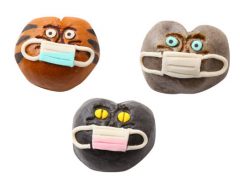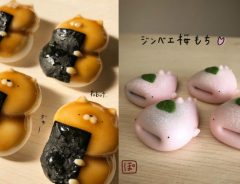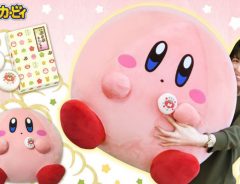- Tags:
- ghost story / Hoichi the Earless / Japanese summer / kaidan / Koizumi Yakumo / Kwaidan / Lafcadio Hearn / Manju / Matsue City / Shimane Prefecture / Wagashi
Related Article
-

Cat’s impossibly round face has people thinking of traditional Japanese sweet cakes
-

7-Eleven Japan celebrates One Piece Film Red with traditional Shanks and Luffy sweets
-

Daughter’s omurice with ketchup message is better than anything maid cafes could make
-

Traditional Japanese sweets maker battles coronavirus with creepy cute “cats wearing masks” dumplings
-

Japanese artist teases appetites with new animal and traditional sweets hybrids
-

This New Giant Kirby Plush Comes With Kirby-Themed Japanese Sweets



Traditional Japanese ways of staying cool in summer
Japan has developed an arsenal of techniques to stay cool in the hot summer months. Some of them, like drinking iced barley tea, eating watermelon, wearing linen clothes which are lightweight and absorb moisture or using traditional hand-held fans, are easy to understand, while others can be more puzzling to visitors. The latter are techniques which work on a psychological level, and are intended to evoke coolness through association. For example, even if there is no breeze in the house, listening to the tinkling of the 風鈴 furin wind chime outside is said to be cooling through association with wind and the sound of the suikinkutsu 水琴窟 (a garden ornament which makes a splashing sound like a koto) in a traditional Japanese garden is said to be cooling by association with water.
Ghost stories
Likewise, Japanese people traditionally listen to ghost stories in summer because they send chills down your spine. In addition to books, kaidan 怪談 as they are known in Japanese, are also enjoyed as told by professional storytellers.
Hoichi the Earless
In the 20th century, kaidan gained some international fame thanks to the efforts of Lafcadio Hearn (or Koizumi Yakumo 小泉八雲 as he is known in his naturalized name), who translated a collection of traditional Japanese ghost stories as "Kwaidan: Stories and Studies of Strange Things" in 1904. One of these stories is 耳なし芳一 Miminashi Hoichi ("Hoichi the Earless").
Hoichi is a blind musician, living in a monastery who sings so well that a ghostly imperial court commands him to perform the epic ballad of their death battle for them. But the ghosts are draining away his life, and the monks set out to protect him by writing a holy mantra over his body to make him invisible to the ghosts. But they forget to cover his ears, so the ghosts take them away. Although now earless, Hoichi is finally free of his ghostly tormentors.
Hoichi no Mimi Manju
What better way to enjoy the Japanese summer than listening to kaidan while snacking on tasty sweets, or is it snacking on sweets while thinking about kaidan?
Either one might have been the idea motivating a group of female students at the University of Shimane's Junior College when they created their Ghost Gifts Research Center ゴーストみやげ研究所, since their main activity seems to be making sweets with a kaidan theme AND helping to promote tourism in Matsue City, where their college is located.
Matsue also happens to be where Lafcadio Hearn lived in Japan, and it's the home of the Lafcadio Hearn Memorial Museum.
Their first commercial success, designed in collaboration of local Matsue manufacturer Nakaura Foods, "Hoichi no Mimi Manju" (Hoichi's Ear Manju) are ear-shaped manju cake filled with white azuki bean paste and a sweet, fig jam center.
Packaging
The box has a an image of Hoichi the blind musician singing while playing his biwa 琵琶 (a Japanese lute) against a pink and red backdrop featuring a cherry blossom and willow motif inspired by the stories in Hearn's Kwaidan. You can also see the official seal and logo of the University of Shimane's Junior College
Photo by © grape Japan
Photo by © grape Japan
An excerpt from the story is printed on the bottom half of the front panel. (We've color processed the image to make the text easier to read):
Photo by © grape Japan
The back panel has information on Matsue, known as the hometown of kaidan in Japan, the city's connection with Lafcadio Hearn, and, of course, an explanation of the manju's ingredients and how the idea came about.
Photo by © grape Japan
The ingredients are: white bean paste, flour, fig jam (includes apple), eggs, sugar, margarine, skimmed milk powder, sweetened egg yolk, mirin, sweetened condensed milk, starch syrup, honey, trehalose, leavening agent, polysaccharide thickener, coloring agents (Red 3, Red 106, red cabbage, red lotus, carotene), pH adjuster, and calcium lactate. Each cake contains 75.2 calories, 1.4 grams of protein, 0.8 grams of fat and 15.7 grams of carbohydrates and 0.07 grams of salt equivalent.
Photo by © grape Japan
Inside, you'll find a little leaflet which provides details on the packaging design on the front...
Photo by © grape Japan
...and introduces the girls of the Ghost Gifts Research Center on the back.
Photo by © grape Japan
Manju
The manju are individually wrapped in plastic. As you can see, they are indeed shaped like ears.
Photo by © grape Japan
And inside, the white bean paste and the fig jam. (Don't worry, no actual ears were used to make them!)
Photo by © grape Japan
Quite delicious, it's hard to just eat one!
Where to buy
If you're visiting Matsue, you'll surely find them in local gift shops on site, or you can order them online at the following website and have them delivered to your hotel or wherever you're staying in Japan. (Delivery to Japanese addresses only).
At 432 JPY for a box of 4 or 648 JPY for a box of 8, including tax, they are very reasonably priced!